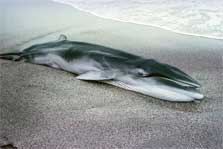Commercial whaling
Commercial hunting has reduced populations of most, if not all the large whales to critical levels. Only the small minke whale (six to seven metres long and weighing five to seven tonnes) is still relatively abundant. Without sufficient information on populations, continued harvesting could cause the extinction of some species.
Of an estimated quarter of a million blue whales, less than 2,000 are estimated to remain. Fin whales are less than five percent and humpback and sei whales 10 to 20 percent of their previous abundance. Of an estimated 60,000 southern right whales, only a few thousand remain. Around 150 breed on New Zealand's subantarctic Campbell and Auckland Islands.
More about commercial whaling.
Southern Ocean Whale Sanctuary protection
In 1946 New Zealand was one of the founding members of the International Whaling Commission (IWC), established to manage the world's whale resources. In 1982 the IWC voted for a moratorium on commercial whaling and in 1994 established the Southern Ocean Whale Sanctuary. The sanctuary covers over 11 million square miles of ocean including all of New Zealand's exclusive economic zone south of 40 degrees south.
All baleen whales within the Southern Ocean Whale Sanctuary are fully protected from commercial whaling. Japan, as the sole objector to the decision, is not bound by it. Added to the Indian Ocean Sanctuary, established by the IWC in 1979, almost one-third of the world's oceans are now a whale sanctuary. However, despite these measures, whales remain at risk from a range of factors.
Pollution

Stranded minke whale
Exposure to chronic pollutants can have a devastating impact on the health and fertility of marine mammals. In particular, concern is now focused on organochlorines, such as PCBs, once widely used in industry. An estimated 65% of the total volume of PCBs ever produced world-wide are still in use, in storage, or have been deposited into landfills. Currently some 20% have made their way into oceans. These pollutants concentrate in fatty tissue such as blubber and milk. Females transfer them in large quantities to their young when suckling.
The World Health Organisation standard classifies any material with a PCB level of 50 parts per million (ppm) as highly toxic waste. Levels of organochlorines found in marine mammals in some parts of the world far exceed this level.
Toxic algal blooms
While these occur naturally they are also thought to be stimulated by factors such as pollution, population growth, changing weather patterns and dredging of the ocean floor. Many `red tide' algae produce phyto-toxins, which can be amongst the most potent natural poisons in the world. Red tides have caused mass mortality of whales and dolphins in the USA and Europe.
Ozone depletion
Since the discovery of the ozone hole over Antarctica, concern has been raised over the effect of increased UV-B radiation. Even small increases could result in major changes to the marine ecosystem.
Global warming
Global warming could affect marine mamals by impacting on the food chain and therefore their food supply.
Whale watching
Whale watching is an expanding tourist industry grossing over $700 million world-wide. In New Zealand, a tourism industry is based on regular visits of sperm and other whale species to the deep waters off the coast of Kaikoura.
Whale watching provides opportunities for education and furthering scientific knowledge. However, the rapid growth of the industry is raising concerns over possible impacts on the behaviour, migration and breeding of whales. The number of whale watching vessels around whales may disturb their normal activity. Physical harm can also be inflicted by collisions and cuts from propellers.
Regulations are necessary to provide adequate safeguards for whales from whale watching vessels. New Zealand's Marine Mammals Protection Regulations are recognised as a world leader in this area.
You can help
- Join Project Jonah or a local group to learn how to rescue stranded whales
- Join a local group which helps with beach clean-ups, etc
- Don't add to the whales' problems: take all rubbish back to shore when you go to sea and don't pour paint stripper and other harmful chemicals down the drain!
Whale strandings
How you can help in a stranding. Find out why marine mammals strand, the stages involved in a stranding response and how you can help.
Report sightings
Your help is urgently sought to look out for southern right whales/tohora around New Zealand and to report sightings immediately.
If you see a whale please report it to DOC as soon as possible. Calls can be made to the 0800 DOCHOT line, 0800 36 24 68.
- Report the sighting using an online form
- Or download the marine mammal sighting form (PDF, 416K) or (Word, 4,300K). These forms include images of marine mammals to help with species identification.
If you can, please photograph the whales. Photos can be used to identify individual whales. The most useful shots are of:
- the left side of the head;
- the full length of the body, particularly showing any identifying marks.
Please also record and give DOC staff the following information:
- the date, time and location of the sighting (GPS coordinates if possible);
- the number of whales and whether any are calves;
- the direction they were travelling; and
- your contact details.
Protection of whales
In New Zealand all whales, dolphins, seals and porpoises are fully protected under the Marine Mammals Protection Act 1978. It is an offence, amongst other things, to harass or disturb marine mammals. Offences carry penalties of up to 6 months imprisonment or fines up to $250,000, and further fines of up to $10,000 for every marine mammal in respect of which the offence is committed.
Related links
- Marine Mammals Protection Act 1978 - on legislation.govt.nz
- Video about whale watching at KaikouraVideo about Project Jonah